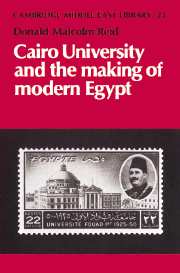Book contents
- Frontmatter
- Contents
- List of illustrations
- List of tables
- Acknowledgments
- Note on academic terminology and transliteration
- List of abbreviations
- Introduction
- Part I The private university, 1908–1919
- Part II The university and the liberal ideal, 1919–1950
- Part III In Nasser's shadow, 1950–1967
- 9 The end of the old regime
- 10 Quality, quantity, and careers
- 11 Mobilizing the university?
- Part IV The university since Nasser
- Conclusion and prospect
- Notes
- Select bibliography
- Index
11 - Mobilizing the university?
Published online by Cambridge University Press: 30 October 2009
- Frontmatter
- Contents
- List of illustrations
- List of tables
- Acknowledgments
- Note on academic terminology and transliteration
- List of abbreviations
- Introduction
- Part I The private university, 1908–1919
- Part II The university and the liberal ideal, 1919–1950
- Part III In Nasser's shadow, 1950–1967
- 9 The end of the old regime
- 10 Quality, quantity, and careers
- 11 Mobilizing the university?
- Part IV The university since Nasser
- Conclusion and prospect
- Notes
- Select bibliography
- Index
Summary
Nasser tried to mobilize Cairo University, and the rest of the country's educational system, in two ways. First, he wanted the university to train the cadres needed for a modern technological society, second, he tried to push the university into articulating and propagating his Arab nationalist and socialist doctrines. His success was limited on both counts. Nasser only sporadically turned his attention to university affairs, his governing style limited the effectiveness of his lieutenants, and he ran into resistance from a diverse university community with a mind and interests of its own.
Technical or liberal education?
Nasser, Kamal al-Din Husayn, and the other Free Officers were practical military men, mostly from lower middle class homes. They saw liberal education as an upper-class luxury inappropriate to the new age. Progressive army officers and expert technicians, not civilian humanists or lawyer-politicians, would lead Egypt into the industrial promised land. Men as diverse as Muhammad Ali, Lord Cromer, Douglas Dunlop, Ismail Sidqi, and the Saadists of the 1940s had also pushed technical education. Now Soviet and American development experts competed to sell Nasser their versions of a technological utopia.
In the other camp, embattled humanists like Taha Husayn and Louis Awad defended liberal education and “knowledge for its own sake,” with which the Egyptian University had been born.
- Type
- Chapter
- Information
- Cairo University and the Making of Modern Egypt , pp. 189 - 212Publisher: Cambridge University PressPrint publication year: 1990



